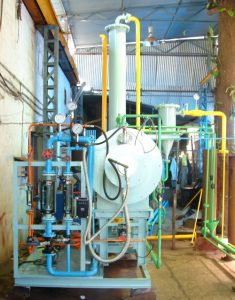 Often coal grinding mills are situated in remote locations. In such cases refilling of CO2 cylinders become a cumbersome process. For such locations, Singhania System Technologists Pvt. Ltd. offers inert gas generator cum inertisation system. As the inert gas, (Combination of CO2 and Nitrogen) is generated from atmospheric air through stoichiometric combustion at the site itself, the need for cylinder refilling is eliminated.
Often coal grinding mills are situated in remote locations. In such cases refilling of CO2 cylinders become a cumbersome process. For such locations, Singhania System Technologists Pvt. Ltd. offers inert gas generator cum inertisation system. As the inert gas, (Combination of CO2 and Nitrogen) is generated from atmospheric air through stoichiometric combustion at the site itself, the need for cylinder refilling is eliminated.
Inert Gas Generator produces Inert Gas by combustion of liquid fuel / Gaseous fuel depending on product quality required. Air along with fuel, at a predetermined ratio, is premixed and combustion takes place in combustion chamber. Inert Gas is produced by stoichiometric combustion or sub-stoichiometric combustion depending on the product quality required.
Inert gas so generated is stored in pressure vessels, to which the inertisation system is connected. The inertisation system consists of inertisation headers with nozzles and mounting pads, interconnecting piping, directional valves, temperature sensors, alarms and manual call points. A PLC/ relay based panel is provided for automatic discharge of Nitrogen on receiving a high temperature/ CO high signal from the sensors.


